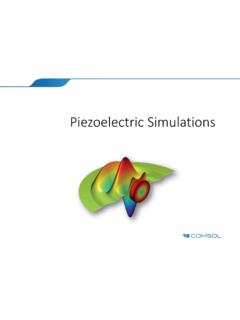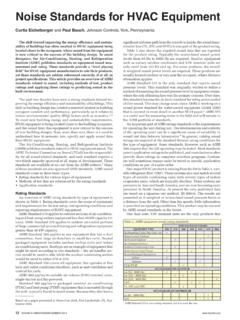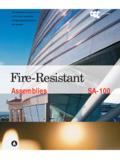Transcription of 1 Introduction to Sonar - MIT OpenCourseWare
1 1 Introduction TO SONAR11 Introduction to SonarrangeabsorptionDITLSLDTNLP assive Sonar EquationSL TL (NL DI)=DTActive Sonar EquationRLSL*IcebergTLTSNLDIDTNL DISL 2TL+TS (RL)=DT1 Introduction TO SONAR2 *SLTLNLUSADTDIH awaiiTomographySL TL (NL DI)=DTParameter definitions: SL = Source Level TL = Transmission Loss NL = Noise Level DI = Directivity Index RL = Reverberation Level TS = Target Strength DT = Detection Threshold1 Introduction TO SONAR3 Summary of array formulasSource Level SL = 10 logI= 10 logpp22(general)Irefref SL = 171 + 10 logP(omni) SL = 171 + 10 logP+ DI(directional)Directivity Index DI = 10 log(ID)(general)IOID= directional intensity (measured at center of beam)IO= omnidirectional intensity(same source power radiated equally in all directions) DI = 10 log(2 L)(line array) DI = 10 log(( D )(disc array) )2)
2 = 20 log( D DI = 10 log(4 LxLy)(rect. array) 23-dB Beamwidth 3dB 3dB= deg.(line array)L 3dB= deg.(disc array)D = , 3dBLxLydeg.(rect. array)901 Introduction TO SONAR4 f = 12 kHz D = m beamwidth = + deg Source level normalized to on axis response 20 40 60 80 90 60 30 030 60 theta (degrees) f = 12 kHz D = m beamwidth = + deg 20 40 60 80 90 60 30 030 60 theta (degrees) f = 12 kHz D = 1 m beamwidth = + deg 20 40 60 80 90 60 30 030 60 theta (degrees))
3 This figure shows the beam pattern for a circular transducer forD/ equalto 2, 4, and 8. Note that the beampattern gets narrower as the diameter 1 Introduction TO SONAR5comparison of 2*J1(x)/x and sinc(x) for f=12kHz and D= 80 70 60 50 40 30 20 100 Source level normalized to on axis response sinc(x)2*J1(x)/x 90 60 3003060theta (degrees) This figure compares the response of a line array and a circular disctransducer. For the line array, the beam pattern is:2sin( 12kLsin ) b( )=12 kLsin whereas for the disc array, the beam pattern is 22J1(12kDsin ) b( )=12 kDsin whereJ1(x) is the Bessel function of the first kind.
4 For the line array, theheight of the first side-lobe is 13 dB less than the peak of the main the disc, the height of the first side-lobe is 17 dB less than the peak ofthe main 1 Introduction TO SONAR6 Line ArrayL/2dzrl A/Lzx L/2 Problem geometryOur goal is to compute the acoustic field at the point (r, )inthefar fieldof a uniformline array of intensityA/L. First, let s find an expression forlin terms ofrand .Fromthe law of cosines, we can write:2l2=r+z2 2rzcos .If we factor outr2from the left hand side, and substitute sin for cos , we get: 2zz22l2=r1 sin +2rrand take the square root of each side we get: 2zz2l=r1 sin +2rrWe can simplify the square root making use of the fact:12(1 +x)p=1+px+p(p 1)2!
5 +p(p 1)(p 2)3!+ 1and keeping only the first term forp=2:(1 +x) 121=1+x2 Applying this to the above expression yields: 12zz2l =r1+ ( sin +2)2rr 21 Introduction TO SONAR7 Finally, making the assuming thatz<<r, we can drop the termzto getr2l =r zsin field calculationFor an element of lengthdzat positionz, the amplitude at the field position (r, )is:A1 i(kl t)dzdp=eLlWe obtain the total pressure at the field point (r, ) due to the line array by integrating:p=AL L/2 L/21le i(kl t)dzbutl =r zsin ,sowecanwrite:p=ALe i(kr t) L/2 L/21r zsin eikzsin dzSince we are assuming we are in the far field ,r>>zsin , so we can replace1r zsin with1rand move it outside the integral:p=ArLe i(kr t) L/2 L/2eikzsin dzNext, we evaluate the integral:p=ArLe i(kr t) eikzsin iksin L/2 L/2 12ikLsin e 12ikLsin A i(kr t)ep=e rLiksin Next move the term1into the square brackets:L12ikLsin e 12ikLsin A i(kr t)ep=e rikLsin ix ixe eand, using the fact that sin(x)=,wecanwrite:2i Asin(1kLsin ) i(kr t)2p=e1rkLsin 2which is the pressure at (r, ) due to the line array.
6 The square of the term in brackets isdefined as thebeam patternb( ) of the array: sin(1kLsin ) 2b( )=21kLsin 21 Introduction TO SONAR8 Steered Line ArrayRecall importance of phase: Spatial phase:kzsin =2 zsin Temporal phase: t=2T ;T=f1-L/2L/2r A/Lzx 0ksin = vertical wavenumber ksin 0= vertical wavenumber reference To make a steered line array, we apply a linear phase shift zksin 0to the excitation ofthe array:dp=A/Leiz(ksin ksin 0)ei tdz(1)rWe can writesin 0zksin 0= zczsin 0zksin 0= T0(z);T0(z)=cThe phase term is equivalent to atime delayT0(z) that varies with position along the linearray.
7 We can re-write the phase term as (ksin ksin 0)ei tikzsin i (t+T0(z))e=eeintegrating Equation 1 yields: Asin(kL2[sin sin 0]) i(kr t)p=r(kLe2[sin sin 0])The resulting beam pattern is a shifted version of the beampattern of the unsteered linearray. The center of the main lobe of the response occurs at = 0instead of =0. 01 Introduction TO SONAR9 steered and unsteered line array (theta_0 = 20 deg) Source level normalized to on axis response 10 20 30 40 50 60 70 80 unsteered beam steered beam 90 60 30 0 30 60 90 120 theta (degrees) This plot shows the steered line array beam pattern2[sin sin 0])sin(kL 2 b( )=(kL2[sin sin 0]) for 0=0and 0= 20 degrees.
8 =1 Introduction TO SONAR10 Example 1: acoustic Bathymetry2 3dBD = m Given: f=12kHz Baffled disc transducer D= acoustic powerP= resolution, =2dtan 3dB=d Ford=2km = =Compute: DI = SL = 3dB=Depth resolution, TF=2d(earliest arrival time)c TL=2r (latest arrival time)c =(TL TF) c/21=d(cos 3dB 1)=d 1 Introduction TO SONAR11 Example 2: SeaBeam Swath Bathymetry2 degrees 90 degrees Transmit: 5 meter unsteered line array (along ship axis)steered No returns No returns returns received Receive array: 5 meterline array (athwartships)only from + 2 degrees 2 degrees Net beam (plan view)Ship s Ship s Track Track One beam, 2 by 2 degrees 100 beams, 2 by 2 degrees (without steering) (with steering) 2 PROPAGATION PART I: SPREADING AND ABSORPTION122 Propagation Part I: spreading and absorptionTable of values for absorption coefficent (alpha) Fall, 1999 Acoustics.
9 Table of attentuation coefficientsfrequency [Hz] alpha [dB/km]1 50000 60000 70000 80000 90000 100000 (100 kHz) 200000 300000 400000 500000 108900 600000 1391741000 (1kHz) 7000002000 800000 2162643151140252044406920994013520176402 23203000 9000004000 1000000 (1 MHz)5000 20000006000 30000007000 40000008000 50000009000 600000010000 (10 kHz) 700000020000 800000030000 900000040000 frequency [Hz] alpha [dB/km]10000000 (10 MHz) 275402 PROPAGATION PART I.
10 SPREADING AND ABSORPTION13 10-510-210210410610410210-21110-3 BoronMgSO4 rl, Range in km (from rl= 10 dB) 10-110310 StructuralS = 35 oC%Absorption of sound in Sea Water f, Frequency, kHz , Absorption in dB/km Shear Viscosity T = 4P = 300 ATM Figure by MIT OCW. Absorption of sound in sea water .2 PROPAGATION PART I: SPREADING AND ABSORPTION14 Absorption of sound in sea waterRelaxation mechanism(conversion of acoustic energy to heat)Four mechanisms shear viscosity ( 10 12sec) structural viscosity ( 10 12sec) magnesium sulfate MgSO4( 10 6sec) [ ppt] boric acid ( 10 4sec) [ ppm]Relaxation time, if <<1, then little loss.












